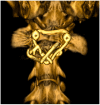Clinical Evaluation of a New Surgical Augmentation Technique for Transarticular Atlantoaxial Fixation for Treatment of Atlantoaxial Instability
- PMID: 37889687
- PMCID: PMC10252017
- DOI: 10.3390/ani13111780
Clinical Evaluation of a New Surgical Augmentation Technique for Transarticular Atlantoaxial Fixation for Treatment of Atlantoaxial Instability
Abstract
The feasibility of a newly developed augmentation of ventral fixation technique for surgical stabilization of atlantoaxial instability was clinically evaluated in a cohort of eleven dogs, and long-term clinical outcomes were retrospectively analyzed. The new technique combines wire/suture fixation through a transverse hole in the axis anchored by two screws placed in the alae atlantis or at the cranial end of plates used to bridge the atlantoaxial joint ventrally. A previous biomechanical study demonstrated good stability of this technique during shear loading, comparable to the stability achieved with other standard techniques. Ten dogs improved clinically after surgery and returned to a normal life within 3-6 months of surgery. One dog developed aphonia, dysphagia, and died of aspiration pneumonia three days after surgery. The augmentation of conventional ventral atlantoaxial fixation with the transverse bony corridor of the proximal axis body may be a valuable way to enhance stabilization of the atlantoaxial joint.
Keywords: atlantoaxial instability; surgical augmentation technique; surgical stabilization; toy breed dog.
Conflict of interest statement
The authors declare no conflict of interest.
Figures





References
-
- McCarthy R.J., Lewis D.D., Hodgood G. Atlantoaxial subluxation in dogs. Compend. Contin. Educ. Pract. Vet. 1995;17:215–226.
-
- Denny H.G., Gibbs C., Waterman A. Atlanto-axial subluxation in the dog: A review of 30 cases and an evaluation of treatment by lag screw fixation. J. Small Anim. Pract. 1988;29:37–47. doi: 10.1111/j.1748-5827.1988.tb02262.x. - DOI
LinkOut - more resources
Full Text Sources

